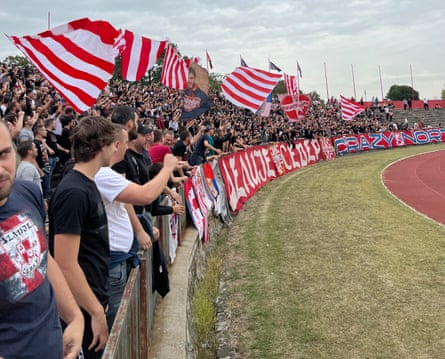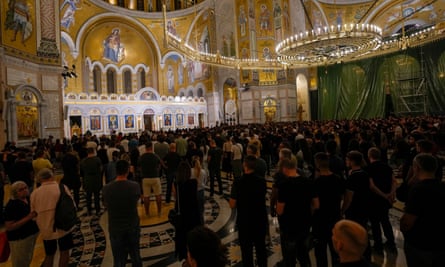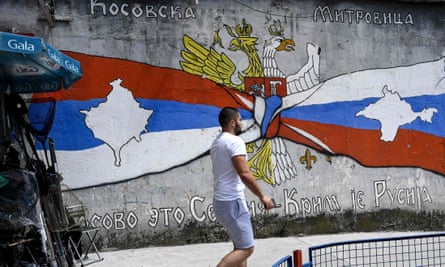In the away stand of the creaking Čika Dača stadium, a hooded and masked football fan summoned the crowd to get on their feet and raise their hands. “Three, two, one …” the man led a countdown through his speakerphone.
“Kosovo is Serbia,” a few hundred fans yelled in unison, moments before the match kicked off.
The away supporters were members of Delije, the name of Red Star Belgrade’s notorious ultras, who have long had a reputation for extraordinary violence and are known for their hardline nationalist views. To watch their team play, the fans travelled on a recent Saturday to the industrial city of Kragujevac, a 90-minute drive south of Belgrade.
Their pro-Serbia chants were applauded and repeated by the fans of the home team, Radnički 1923, sitting on brick seats on the other side of the stadium.
Before half-time, Delije unrolled a banner that read: “When the army returns to Kosovo”.

Few places in the Balkans reveal the volatile ethnic politics of the region as much as football stadiums, where supporters regularly chant slurs that recall those employed during the ethnic-cleansing drives of the 1990s.
“We need to finish them off, stop dragging our feet,” said a talkative, skinny Red Star fan during half-time, declining to give his name.
He was not referring to his team’s opponent but to the ethnic Albanian population that declared its independence from Serbia 15 years ago, almost a decade after a guerrilla uprising against Serbian rule.
With much of the game spent ducking firecrackers, the actual football match appeared secondary.
The Red Star ultra, like many others on the day, was wearing a T-shirt emblazoned with the face of Stefan Nedeljković, one of the three ethnic Serbs killed during last month’s ambush by Serbian paramilitaries on Kosovan police that sparked one of the most serious regional crises in years between Belgrade and the breakaway state.
The battle between Kosovan police and 30 armed Serbs holed up in a monastery temporarily turned a quiet village in northern Kosovo into a war zone.
About 50,000 Serbs who live in north Kosovo do not recognise Pristina institutions and see Belgrade as their capital. They have often clashed with Kosovan police and international peacekeepers, but last month’s violence was the worst in years.
“Stefan is a hero and his death needs to be avenged,” said the Red Star supporter, pointing to his shirt.
Ultranationalism is a familiar terrain for the Red Star fans. The team’s founder once described the team as the guardian of Serbian identity and the Orthodox faith.
But critics of the Serbian leader, Aleksandar Vučić, say that the president’s potent mix of ethnic chauvinism and demagogy, which resembles that of Russia’s Vladimir Putin, has allowed the ultranationalist sentiments to grow outside Serbia’s football stadiums.
“Some of the hatred promoted by the hooligans has been completely normalised in society. They don’t just represent the fringes, their anti-western messages resonate across the country,” said Vladimir Arsenijević, a prominent Serbian writer who heads the Krokodil NGO, a group that promotes dialogue and reconciliation in the western Balkans.

A poll last year showed that for the first time in two decades, the number of Serbians who are against joining the EU is higher than those who want to become a member, a testament to the government’s authoritarian and anti-western rhetoric in domestic politics.
In theory a candidate for EU accession, the country appears torn between the west and Russia, a traditional Slavic and Orthodox Christian ally.
As he consolidated power, Vučić, a self-proclaimed former Red Star ultra himself, steadily transformed Serbia into an autocracy.
Vučić opponents such as Arsenijević have accused him of taking control of the media through the state telecommunications company that bought up local TV stations, which Arsenijević says are vital in promoting a culture of violence.
The Serbian leader has also sought to court and co-opt the football hooligans, said James Montague, a researcher who has extensively studied the violent, complex world of ultras in Serbia.

“Vučić understood that this is a powerful and dangerous constituency that can make or break a president,” said Montague.
“The ultras can quickly be mobilised for political goals if needed. At the same time, the authorities listen carefully to what is being shouted at the stands.”
While Red Star ultras no longer participate in outright inter-ethnic violence, as was the case in the 1990s when the warlord Arkan commanded a group of hooligans, they still feature in scenes that have included women being beaten up and LGBTQ+ marches being disrupted in Belgrade.
Vučić, whose political roots are in far-right nationalism, has given interviews about how he was in the stands during a mythical 1990 football fight between the Red Star and Dinamo Zagreb teams, which has sometimes been seen as the true beginning of the Balkan wars.
Walking around Belgrade, another, more visible footprint of Serbian nationalism is hard to ignore.
Among the upmarket boutiques and hipster coffee shops in the city, one can easily spot pro-Russian and ultranationalist murals, often intermixed with the faces of football fans killed in brawls and notorious war criminals, including the jailed former Bosnian Serb commander Ratko Mladić.
“Living among these murals pollutes the mind,” said Arsenijević.

Part of Krokodil’s core work is the fight against murals across the country that the group says “endorse hatred, racism, and sexism”.
“By constantly seeing the murals, people who would otherwise be decent humans little by little accept all these hateful messages,” Arsenijević said, comparing the process to the hypothetical boiled frog phenomenon.
“In the end, this has a direct impact on the political situation with Kosovo,” he said.
On the ground in northern Kosovo, Jovana Radosavljevic said she could feel inter-ethnic relations between Albanians and Serbs worsening, after the latest fighting.
“You can see the change in the behaviour of people. This is something that concerns me,” said Radosavljevic, who heads the New Social Initiative, an NGO that works on reconciliation among ethnic communities.
But despite the growing tensions, analysts believe it is unlikely that Vučić, citing a threat to the Serbian minority in northern Kosovo, will send troops over the border and annex the region, a scenario that keeps western policymakers awake at night.
“We aren’t approaching a new escalation; there won’t be a war like we have seen in the 1999s,” said Ivan Vejvoda, a senior fellow at the Institute of Human Sciences in Vienna.
“Serbian politicians understand very well that you don’t touch Nato,” Vejvoda said, referring to the roughly 4,000 Nato soldiers currently in Kosovo.
After US warnings that it could face punitive measures for what the White House called an “unprecedented” buildup of Serbian troops and armour, Vučić announced that he had pulled some of its troops back from Kosovo.
But, despite signs that the immediate crisis over Kosovo has been defused, Arsenijević remains sombre about Serbia’s immediate future. “Our society is in a downward spiral,” he said.
While Arsenijević welcomed the recent anti-violence protests in which tens of thousands of people gathered in Belgrade after two back-to-back shootings that killed 18 people, he fears society will continue to live in a state of “constant tensions”.
“The authorities are sustaining a climate of violence,” he said.
Source : The Guardian















